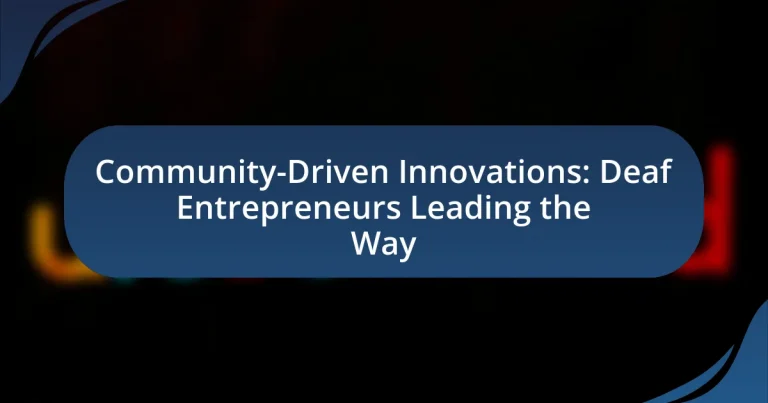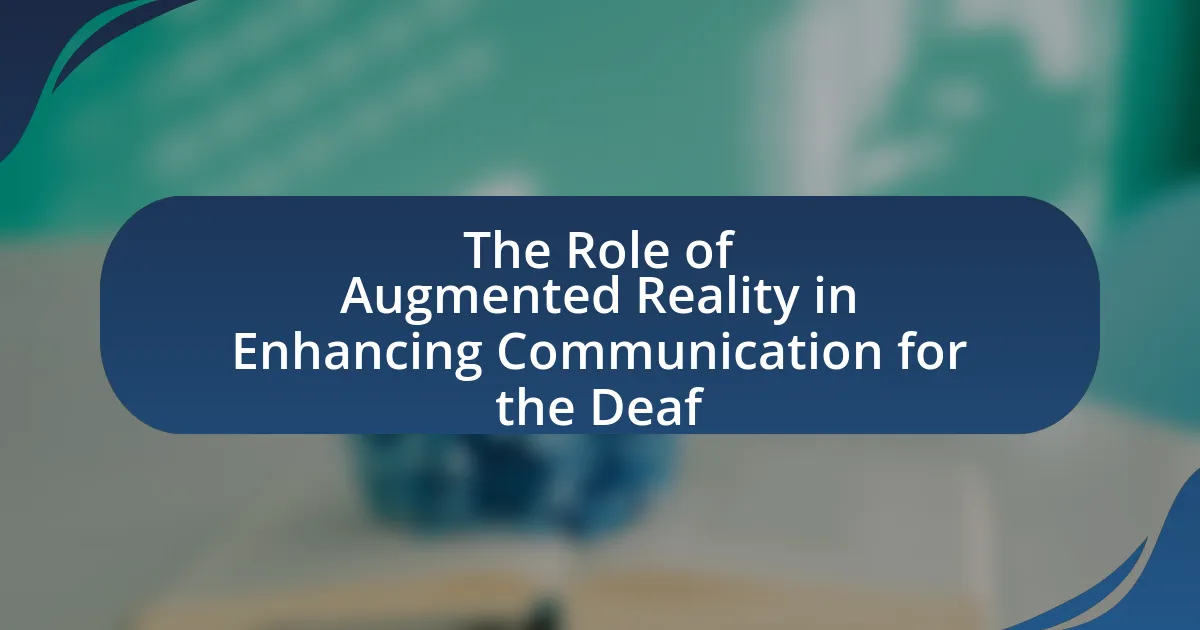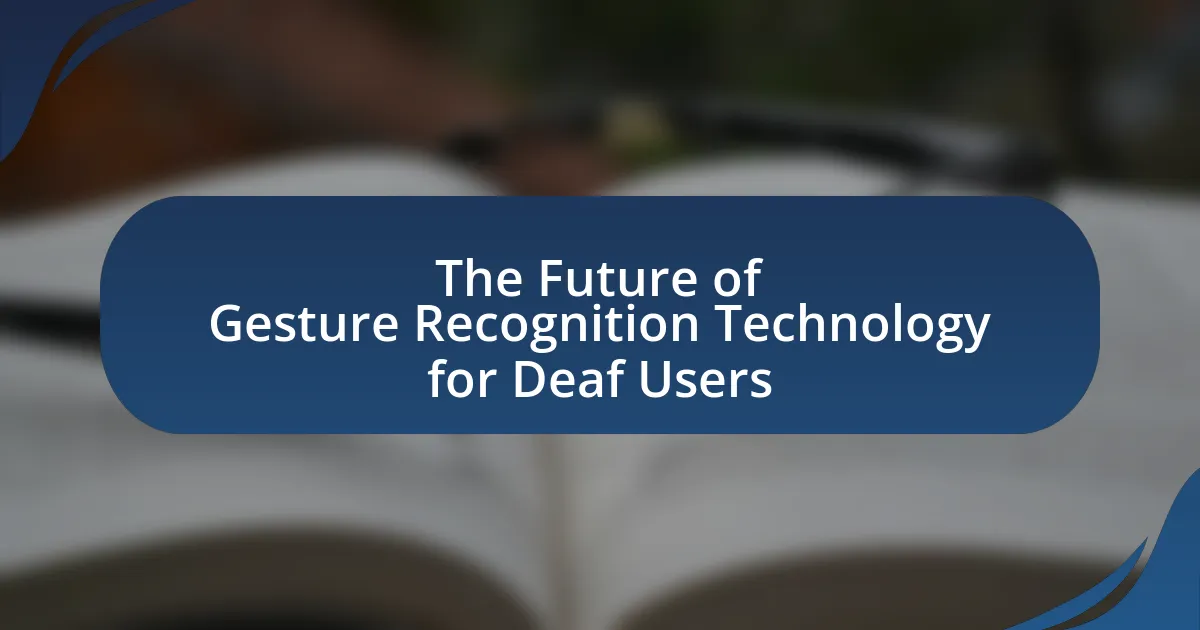Community-driven innovations are pivotal in the context of Deaf entrepreneurs, who utilize their unique perspectives to create products and services that address the specific needs of both the Deaf community and society at large. This article explores how Deaf entrepreneurs contribute to innovation through their lived experiences, fostering accessibility and inclusivity in various sectors. It highlights the challenges they face, including communication barriers and limited access to funding, while also showcasing success stories that exemplify their impact on the entrepreneurial landscape. Additionally, the article discusses the importance of community support and resources in enhancing the growth and sustainability of Deaf-led businesses, ultimately emphasizing the role of collaboration in driving innovation.

What are Community-Driven Innovations in the Context of Deaf Entrepreneurs?
Community-driven innovations in the context of Deaf entrepreneurs refer to collaborative efforts that leverage the unique perspectives and experiences of the Deaf community to create products, services, or solutions that address specific needs. These innovations often arise from the collective input and participation of Deaf individuals, fostering an inclusive environment that values their insights. For instance, initiatives like Deaf-owned businesses that utilize sign language in customer service exemplify how community-driven approaches can enhance accessibility and engagement. Research indicates that such innovations not only empower Deaf entrepreneurs but also contribute to the economic growth of the community, as seen in the rise of Deaf-led startups that cater to both Deaf and hearing audiences.
How do Deaf entrepreneurs contribute to community-driven innovations?
Deaf entrepreneurs contribute to community-driven innovations by leveraging their unique perspectives and experiences to identify gaps in the market and create solutions that address the needs of both the Deaf community and the broader society. Their innovations often focus on accessibility, communication technologies, and inclusive services, which not only benefit Deaf individuals but also enhance overall community engagement. For instance, companies like Aira and SignAll have developed technologies that facilitate communication between Deaf and hearing individuals, showcasing how Deaf entrepreneurs can drive advancements that promote inclusivity. This approach not only fosters economic growth within the Deaf community but also encourages collaboration and understanding among diverse groups, ultimately leading to more cohesive and innovative communities.
What unique perspectives do Deaf entrepreneurs bring to innovation?
Deaf entrepreneurs bring unique perspectives to innovation through their lived experiences, which foster creativity and problem-solving skills. Their ability to navigate a predominantly hearing world enhances their adaptability and resilience, leading to innovative solutions that address accessibility and communication barriers. For instance, Deaf entrepreneurs often develop products and services that cater specifically to the needs of the Deaf community, such as visual communication tools and technologies. This focus not only drives inclusivity but also opens new markets, as evidenced by the growth of businesses like Sorenson Communications, which provides video relay services. Their distinct viewpoint encourages a broader understanding of user experience, ultimately leading to innovations that benefit both Deaf and hearing individuals.
How does the Deaf community influence the entrepreneurial landscape?
The Deaf community significantly influences the entrepreneurial landscape by fostering innovation and creating unique business opportunities that cater to their specific needs and preferences. Deaf entrepreneurs often leverage their cultural insights and experiences to develop products and services that enhance accessibility and inclusivity, such as technology solutions for communication barriers. For instance, the rise of video relay services and captioning technologies has been driven by Deaf entrepreneurs who understand the challenges faced by their community. This entrepreneurial activity not only addresses gaps in the market but also promotes awareness and understanding of Deaf culture, leading to broader societal changes in how businesses approach inclusivity.
Why is community involvement crucial for Deaf entrepreneurs?
Community involvement is crucial for Deaf entrepreneurs because it fosters a supportive network that enhances business opportunities and access to resources. Engaging with the community allows Deaf entrepreneurs to build relationships, share knowledge, and collaborate on projects, which can lead to innovative solutions tailored to the needs of the Deaf population. Research indicates that businesses with strong community ties often experience increased customer loyalty and brand recognition, as seen in studies highlighting the success of Deaf-owned businesses that actively participate in local events and initiatives.
What role does community support play in the success of Deaf-led businesses?
Community support is crucial for the success of Deaf-led businesses as it fosters a network of resources, advocacy, and customer loyalty. This support enables Deaf entrepreneurs to access funding, mentorship, and collaboration opportunities that are often limited due to communication barriers. For instance, research indicates that businesses with strong community ties experience higher customer retention rates, which is particularly significant in the Deaf community where word-of-mouth and shared experiences drive patronage. Additionally, community organizations often provide platforms for visibility and outreach, enhancing the overall sustainability and growth of Deaf-led enterprises.
How can community networks enhance innovation among Deaf entrepreneurs?
Community networks can enhance innovation among Deaf entrepreneurs by providing access to resources, mentorship, and collaboration opportunities tailored to their unique needs. These networks facilitate knowledge sharing and skill development, enabling Deaf entrepreneurs to leverage collective expertise and experiences. For instance, studies show that peer support within community networks can lead to increased confidence and creativity, which are crucial for innovation. Additionally, community networks often create inclusive environments that foster the exchange of ideas, ultimately driving entrepreneurial growth and innovation among Deaf individuals.
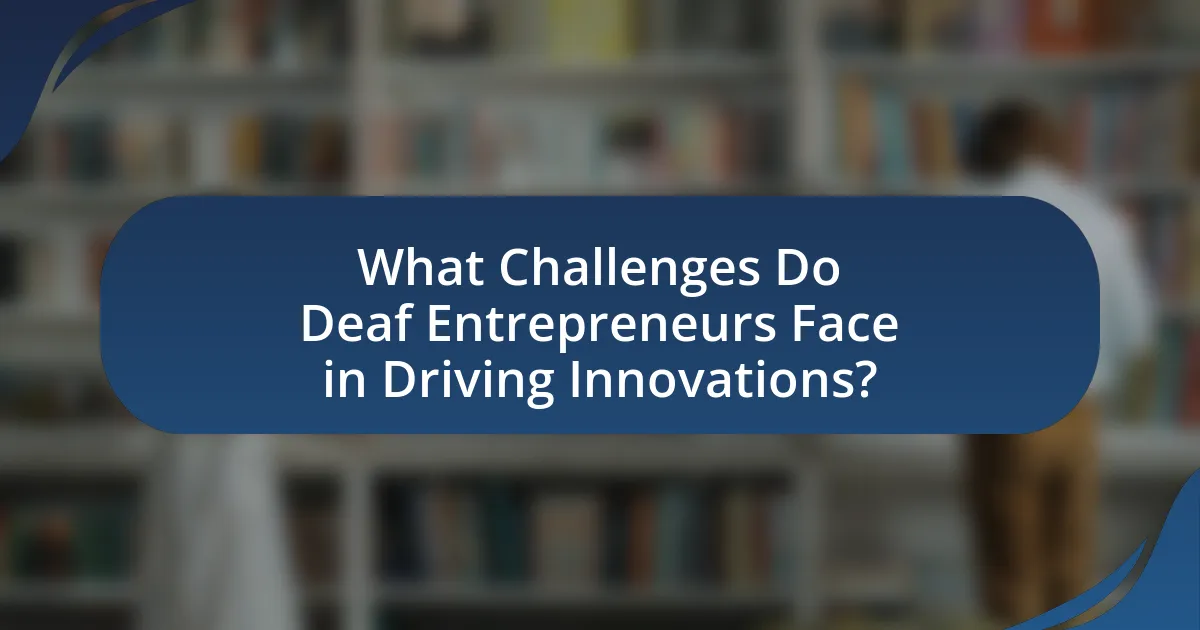
What Challenges Do Deaf Entrepreneurs Face in Driving Innovations?
Deaf entrepreneurs face significant challenges in driving innovations, primarily due to communication barriers, limited access to funding, and a lack of representation in the business ecosystem. Communication barriers hinder effective networking and collaboration, which are crucial for innovation. For instance, many investors and business partners may not be familiar with sign language, making it difficult for deaf entrepreneurs to convey their ideas and secure support.
Additionally, studies indicate that deaf individuals often encounter difficulties in accessing traditional funding sources, as they may lack the necessary connections or face biases from investors who are not accustomed to working with deaf founders. According to a report by the National Deaf Center on Postsecondary Outcomes, only 48% of deaf individuals are employed, which further limits their financial resources and opportunities to innovate.
Moreover, the underrepresentation of deaf individuals in entrepreneurship leads to a lack of role models and mentorship, which can stifle creativity and innovation. This combination of factors creates a challenging environment for deaf entrepreneurs striving to bring their innovative ideas to fruition.
How do communication barriers impact Deaf entrepreneurs?
Communication barriers significantly hinder Deaf entrepreneurs by limiting their access to networking opportunities and essential business resources. These barriers often result in difficulties in engaging with hearing clients, investors, and collaborators, which can restrict market reach and growth potential. For instance, a study by the National Deaf Center on Postsecondary Outcomes found that Deaf individuals face challenges in accessing information and services due to communication gaps, leading to lower entrepreneurial success rates compared to their hearing counterparts. This lack of effective communication can also contribute to feelings of isolation and reduced confidence in business settings, further impacting their ability to thrive in competitive environments.
What strategies can Deaf entrepreneurs use to overcome communication challenges?
Deaf entrepreneurs can use several strategies to overcome communication challenges, including leveraging technology, utilizing visual communication methods, and fostering inclusive environments. Technology such as video relay services and instant messaging apps enables real-time communication, while visual aids like infographics and sign language interpreters enhance understanding. Additionally, creating inclusive workplaces that prioritize accessibility and training for hearing employees promotes effective collaboration. Research indicates that businesses with inclusive practices experience higher employee satisfaction and productivity, demonstrating the effectiveness of these strategies in overcoming communication barriers.
How do these barriers affect their business operations and growth?
Barriers such as communication challenges, limited access to funding, and societal stigma significantly hinder the business operations and growth of deaf entrepreneurs. These obstacles restrict their ability to network effectively, secure investments, and market their products or services, ultimately leading to reduced visibility and competitiveness in the marketplace. For instance, a study by the National Deaf Center on Postsecondary Outcomes found that deaf individuals face higher unemployment rates, which can be attributed to these systemic barriers, thereby limiting their entrepreneurial potential and overall economic contributions.
What financial obstacles do Deaf entrepreneurs encounter?
Deaf entrepreneurs encounter significant financial obstacles, primarily due to limited access to funding and resources. Traditional funding sources often overlook Deaf individuals, leading to a lack of tailored financial products and services that meet their unique needs. For instance, a study by the Kauffman Foundation found that minority entrepreneurs, including Deaf individuals, face higher barriers in securing loans compared to their hearing counterparts. Additionally, communication barriers can hinder Deaf entrepreneurs from effectively pitching their business ideas to investors, further exacerbating their financial challenges.
How can Deaf entrepreneurs access funding and resources?
Deaf entrepreneurs can access funding and resources through specialized grants, loans, and support programs designed for individuals with disabilities. Organizations such as the National Association of the Deaf and the Small Business Administration offer resources tailored to Deaf entrepreneurs, including financial assistance and mentorship programs. Additionally, crowdfunding platforms and community-based initiatives provide alternative funding avenues, allowing Deaf entrepreneurs to connect with supporters who value their innovative contributions. Research indicates that targeted support for Deaf entrepreneurs can enhance their business success, as evidenced by programs that have successfully increased access to capital and resources for this community.
What are the implications of limited access to traditional funding sources?
Limited access to traditional funding sources significantly hampers the growth and sustainability of community-driven innovations, particularly among Deaf entrepreneurs. This restriction often leads to reduced opportunities for business development, limiting the ability to scale operations and reach broader markets. For instance, a study by the Kauffman Foundation indicates that startups with access to funding are 50% more likely to succeed in their first five years compared to those without. Consequently, Deaf entrepreneurs may face increased barriers to entry in competitive markets, resulting in a lack of representation and diversity in entrepreneurship.
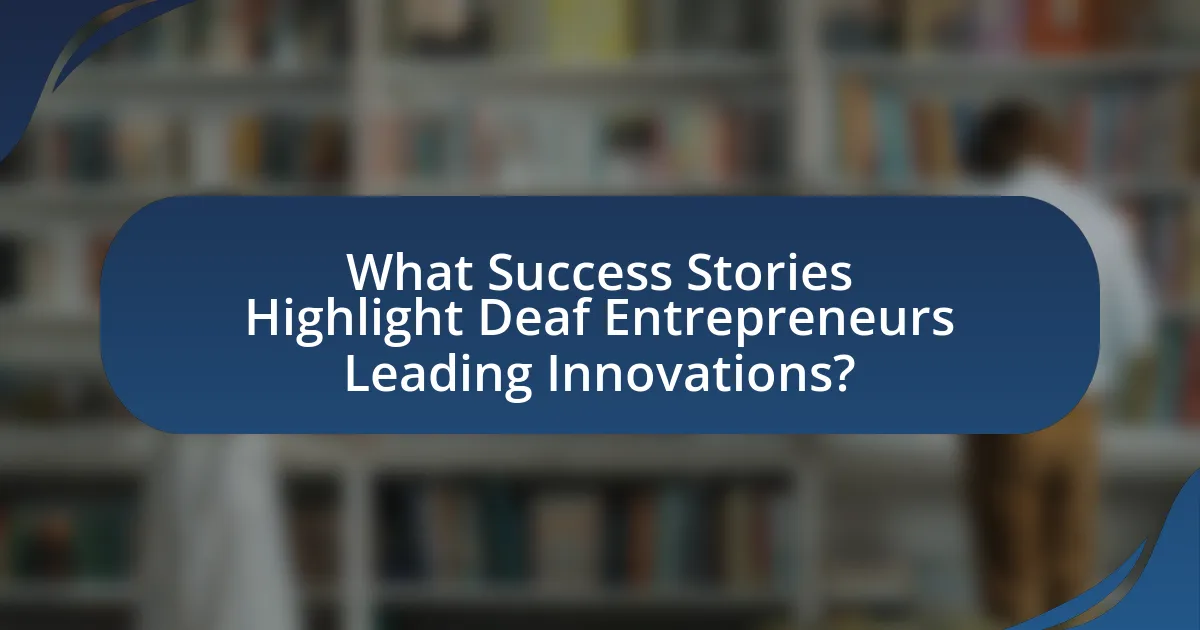
What Success Stories Highlight Deaf Entrepreneurs Leading Innovations?
Deaf entrepreneurs have made significant strides in innovation, with notable success stories including Haben Girma, who became the first deafblind graduate of Harvard Law School and advocates for accessibility in technology, and Chris Fonseca, a deaf entrepreneur who created a successful dance company that promotes inclusivity. These individuals exemplify how deaf entrepreneurs are leading innovations by addressing accessibility challenges and creating inclusive environments. Their achievements highlight the potential of deaf individuals to drive change and inspire others within their communities.
Who are some notable Deaf entrepreneurs making an impact?
Notable Deaf entrepreneurs making an impact include Haben Girma, who is recognized for her advocacy for disability rights and her work as a lawyer, and Nyle DiMarco, an actor and model who promotes Deaf culture and education through his foundation. Haben Girma became the first Deafblind graduate of Harvard Law School and has received numerous accolades for her contributions to accessibility and inclusion. Nyle DiMarco, winner of “America’s Next Top Model,” founded the Nyle DiMarco Foundation to support Deaf education and awareness, further highlighting the influence of Deaf entrepreneurs in promoting community-driven innovations.
What innovations have these entrepreneurs introduced to their communities?
Deaf entrepreneurs have introduced several innovations to their communities, primarily focusing on accessibility and inclusion. For instance, they have developed communication technologies, such as video relay services and mobile applications, that facilitate real-time communication for deaf individuals. These innovations not only enhance social interaction but also improve access to essential services, such as healthcare and education. Additionally, deaf entrepreneurs have created businesses that employ deaf individuals, fostering economic empowerment and promoting awareness of deaf culture within the broader community. These initiatives have been supported by organizations like the National Association of the Deaf, which highlights the importance of such innovations in bridging gaps and creating inclusive environments.
How have their stories inspired others within the Deaf community?
The stories of Deaf entrepreneurs have inspired others within the Deaf community by showcasing resilience and innovation in overcoming barriers. These narratives highlight successful business ventures that not only challenge societal perceptions but also create role models for aspiring Deaf individuals. For instance, the success of Deaf-owned businesses like “Deaf Coffee Shop” in the United States has demonstrated the potential for economic independence and community engagement, encouraging others to pursue their entrepreneurial dreams. Additionally, these stories often emphasize the importance of accessibility and inclusivity in business practices, motivating others to advocate for similar values within their own ventures.
What lessons can be learned from successful Deaf-led innovations?
Successful Deaf-led innovations demonstrate the importance of inclusivity and accessibility in product design and service delivery. These innovations often arise from the unique perspectives and experiences of Deaf entrepreneurs, who identify gaps in the market that hearing individuals may overlook. For instance, companies like Sorenson Communications have developed video relay services that cater specifically to the Deaf community, showcasing how understanding user needs can lead to effective solutions. Additionally, these innovations highlight the value of community engagement, as Deaf-led initiatives often involve collaboration with community members to ensure that products meet their specific requirements. This approach not only fosters trust but also enhances the relevance and usability of the innovations.
How can these lessons be applied to future entrepreneurial endeavors?
The lessons learned from community-driven innovations by Deaf entrepreneurs can be applied to future entrepreneurial endeavors by emphasizing the importance of inclusivity and collaboration. These entrepreneurs demonstrate that leveraging diverse perspectives fosters creativity and innovation, which can lead to unique solutions in various markets. For instance, the success of Deaf-led businesses often stems from their ability to identify unmet needs within their communities, showcasing how understanding specific customer segments can drive business growth. Additionally, the use of technology to enhance communication and accessibility can serve as a model for other entrepreneurs aiming to reach broader audiences. This approach not only addresses market gaps but also promotes social responsibility, which is increasingly valued by consumers.
What best practices emerge from the experiences of successful Deaf entrepreneurs?
Successful Deaf entrepreneurs often emphasize the importance of leveraging community support and networks as a best practice. This approach allows them to access resources, mentorship, and collaboration opportunities that are vital for business growth. For instance, many Deaf entrepreneurs actively participate in organizations like the National Association of the Deaf, which provides networking opportunities and advocacy for Deaf-owned businesses. Additionally, successful Deaf entrepreneurs frequently utilize technology to enhance communication and accessibility, ensuring that their businesses can effectively reach a wider audience. Research indicates that Deaf entrepreneurs who embrace innovative communication tools, such as video relay services and social media platforms, can significantly improve customer engagement and service delivery. These practices highlight the critical role of community and technology in the success of Deaf entrepreneurs.
What practical steps can aspiring Deaf entrepreneurs take to succeed?
Aspiring Deaf entrepreneurs can succeed by leveraging their unique perspectives and building strong networks within the Deaf community. Establishing connections with other Deaf individuals and organizations can provide essential support, mentorship, and resources tailored to their specific needs. Research indicates that community engagement significantly enhances entrepreneurial success; for instance, a study by the Kauffman Foundation found that entrepreneurs with strong networks are 50% more likely to succeed in their ventures. Additionally, utilizing technology, such as social media and video conferencing, can help Deaf entrepreneurs reach wider audiences and collaborate effectively. By focusing on these practical steps, Deaf entrepreneurs can create sustainable businesses that reflect their community’s values and needs.
How can they leverage community resources for their business growth?
Deaf entrepreneurs can leverage community resources for their business growth by actively engaging with local organizations, networks, and support groups that cater to their unique needs. These resources often provide access to mentorship, funding opportunities, and training programs specifically designed for individuals with disabilities. For instance, organizations like the National Association of the Deaf offer resources that can help deaf entrepreneurs connect with potential investors and gain insights into market trends. Additionally, community workshops and networking events can facilitate partnerships and collaborations that enhance visibility and customer reach, ultimately driving business growth.
What strategies should they adopt to foster innovation in their ventures?
To foster innovation in their ventures, deaf entrepreneurs should adopt collaborative strategies that leverage community engagement and diverse perspectives. By actively involving community members in the innovation process, these entrepreneurs can identify unique needs and generate creative solutions tailored to their audience. Research indicates that inclusive practices enhance problem-solving capabilities, as diverse teams are 35% more likely to outperform their peers in innovation (McKinsey & Company, 2020). Additionally, establishing partnerships with organizations that support the deaf community can provide valuable resources and insights, further driving innovative outcomes.
